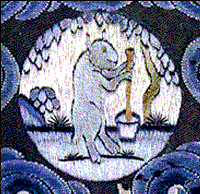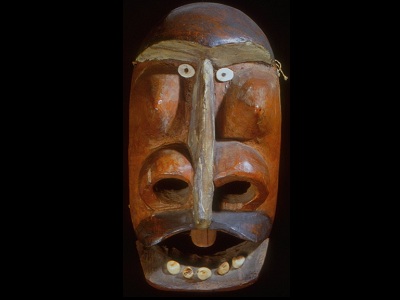Early humans have always looked at space or their world and the objects or things in them and what they couldn't understand they would make that object a god or goddess or something equally hard to understand...
The Native American Algonquian tribe called the first full moon in January the Wolf Moon. This name represented the hungry wolves that howl at night. They used the moon to represent their connection to nature, animals and their culture.
The Chinese believed there were 12 moons and they were made of water. Each moon represented one month. The mother of the moons was the Sun.
The Inuit people of Greenland believe the Moon chases the Sun. The Moon works so hard to keep up and gets thinner and thinner. (I kind of like this story!)
People look at the moon today and ask, "Do you see the bear on the moon?" or "Do you see the rabbit?" or "Do you see the crab on the moon?" What do you see?
Making up stories about moons and planets helps our brains process what we see. Many times when we see something we don't understand we make sense of it using what we are familiar with, like rabbits, bears and crabs. Look at this picture:
This is a strange, real image from Mars. The rover Curiosity took this series of pictures. Experts have been looking at it for awhile and can't figure out what is going on? Can you make sense of these photos? What is your brain telling you it might be?
Search This Blog
Friday, August 30, 2019
Thursday, August 29, 2019
Evolution of the Moon
How did the moon get where it is today? That is a leading scientific question. One idea is called "the giant impact" hypothesis, a Mars sized object crashed into Earth and took a big chunk of Earth with it and dragged it out into space. Basically, the Moon is a large piece of Earth that has been molded into a rocky sphere by gravity.
This simulation using a "sand-like" substance does a good job of showing how an object could have hit the Earth and the resulting debris became the moon. Since we haven't done any digging on the Moon, it isn't certain that there are any fossils. But in 2024 NASA is sending men and women to the moon to do extensive experiments to find out what the Moon is really made of.
From the creation of the Moon we know that during this formation period of our Solar System, planets, asteroids, meteors and other space stuff was not neat and tidy. With gravity pulling objects in and flinging other objects around there was a lot of stuff flying everywhere.
Our Moon absorbed a lot of that debris, and who's to say, the Moon may have saved us from getting hit on Earth?
We really need the Moon. Someone asked me today..."What would happen if the Moon were to suddenly be destroyed? What would happen to us?"
Well, I can make a few inferences...first, we wouldn't have tides. If we didn't have tides animals that live in water and on land at the same time might not survive because they need water to live in water part of the day to survive.
Second, the Earth is tilted 23.5 degrees, if the Moon wasn't there we would be wobbling madly all around, kind of like a top that is bobbling around on a table top. The Moon and Earth share a pull of gravity that keeps us in balance.
The Moon keeps us stable. I rather like seeing the Moon in the sky and during a New Moon, I actually kind of miss it being up in the sky. I'm glad we got the Moon and not Venus. I really like our little satellite.
Wednesday, August 28, 2019
Revolution Vs. Rotation
What's the difference between revolution and rotation. I'm not talking about a historical revolution...like the revolution of the Sun, or the Earth, or the Moon...you know, science stuff...
We know that the Earth revolves around the Sun and it takes about 365 days. In fact there are 8 planets and a bunch of asteroids and some dwarf planets that revolve around our Sun.
So, revolution has to do with going around something. The big difference between revolution and rotation is that when an object rotates it just spins in one spot, or like our Earth, it spins AND revolves.
Rotating objects are a pattern in our Solar System too.
Uh! Oh snap! Look at Earth's rotation compared to Venus's rotation! Whaaaat?
Our Sun even rotates.
Revolving and rotation does involve motion and going around, but from there we need to understand "how" the object goes around. It's a case of similar-not-similar. Confusing, I know!
Don't worry! You'll get it!
We know that the Earth revolves around the Sun and it takes about 365 days. In fact there are 8 planets and a bunch of asteroids and some dwarf planets that revolve around our Sun.
So, revolution has to do with going around something. The big difference between revolution and rotation is that when an object rotates it just spins in one spot, or like our Earth, it spins AND revolves.
Rotating objects are a pattern in our Solar System too.
Uh! Oh snap! Look at Earth's rotation compared to Venus's rotation! Whaaaat?
Our Sun even rotates.
Revolving and rotation does involve motion and going around, but from there we need to understand "how" the object goes around. It's a case of similar-not-similar. Confusing, I know!
Don't worry! You'll get it!
Tuesday, August 27, 2019
Moon Phase Angle and Revolution
First of all, lets talk about what Moon Phases are not. One misconception or idea that isn't quite correct is that the Earth can cast a shadow on the Moon. Not true! The Sun is GINORMOUS!
As you can see, this photo above shows how any sun rays that are able to go around the Earth, will go around the Earth! With this in mind how does a Moon Phase happen?
The Earth is rotating...and moving around the Sun. Plus, the Moon is revolving around the Earth. This little video makes it seem like the Moon is moving super fast, but look at the numbers. It takes 29 days for the Moon to go around the Earth! Because of all this movement, the Moon is going to take on different angles of Sunlight every Earth Day. What we see from Earth as we look upon the Moon creates a different look or phase of the Moon.
It's pretty simple, the Moon Phases are related to orbital movement. When you think about it too hard that's when your brain starts to explode...
As you can see, this photo above shows how any sun rays that are able to go around the Earth, will go around the Earth! With this in mind how does a Moon Phase happen?
The Earth is rotating...and moving around the Sun. Plus, the Moon is revolving around the Earth. This little video makes it seem like the Moon is moving super fast, but look at the numbers. It takes 29 days for the Moon to go around the Earth! Because of all this movement, the Moon is going to take on different angles of Sunlight every Earth Day. What we see from Earth as we look upon the Moon creates a different look or phase of the Moon.
It's pretty simple, the Moon Phases are related to orbital movement. When you think about it too hard that's when your brain starts to explode...
Subscribe to:
Posts (Atom)


























